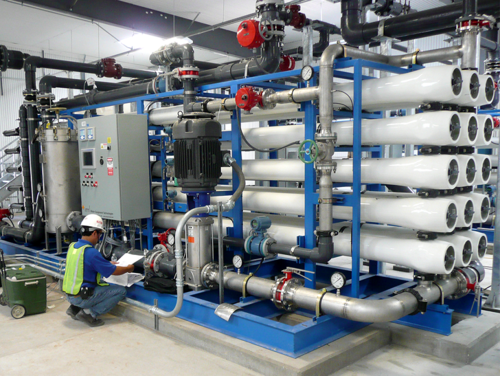Ingenious PFAS Treatment Solutions for Safer Water
The boosting frequency of PFAS contamination in water supplies demands a critical assessment of cutting-edge treatment services. Advanced filtering technologies and unique chemical therapies present promising methods for decreasing these consistent pollutants. Additionally, emerging bioremediation methods supply an even more sustainable method to dealing with PFAS challenges. As regulatory frameworks remain to adjust, recognizing the effectiveness and scalability of these remedies ends up being extremely important. What effects do these advancements hold for public wellness and environmental repair, and how can stakeholders successfully apply them in diverse contexts?
Overview of PFAS Contamination
PFAS contamination has actually become a substantial environmental and public wellness problem. Per- and polyfluoroalkyl substances (PFAS) are a team of artificial chemicals known for their determination in the environment and body, leading them to be frequently referred to as "forever chemicals." These substances have actually been commonly used in numerous sectors, including firefighting foams, water-repellent textiles, and food packaging, largely due to their water- and grease-resistant properties.
The widespread use of PFAS has actually led to their discovery in soil, water materials, and also in the blood of humans and pets. Research studies have connected PFAS direct exposure to many health and wellness issues, consisting of developing effects in infants, body immune system dysfunction, and numerous kinds of cancer. Furthermore, the ecological perseverance of these substances complicates their degradation and removal, raising issues regarding long-term eco-friendly impacts.
Regulative bodies are increasingly applying rigorous standards to monitor and minimize PFAS degrees in alcohol consumption water and other ecological mediums. As recognition of PFAS contamination expands, it has come to be important for communities and markets to seek reliable treatment options to reduce direct exposure and secure public health.
Advanced Filtering Technologies
As the seriousness to resolve PFAS contamination heightens, advanced filtering innovations have actually become a pivotal part in the remediation initiatives aimed at getting rid of these consistent chemicals from water sources. These technologies take advantage of innovative mechanisms to efficiently target and capture PFAS substances, which are notoriously resistant to traditional therapy methods.
Among one of the most promising strategies is using granular triggered carbon (GAC), which adsorbs PFAS molecules because of its high surface area and porous framework. This technique has been extensively implemented in both local and industrial setups, demonstrating substantial reductions in PFAS focus. Additionally, ion exchange resins have actually gotten traction, specifically made to precisely bind PFAS ions from water, therefore promoting their elimination.
Membrane purification technologies, such as reverse osmosis and nanofiltration, also reveal effectiveness in PFAS elimination by physically separating pollutants from water - pfas management. These systems can achieve high degrees of pureness, making them appropriate for alcohol consumption water applications
Chemical Treatment Advancements
Many chemical treatment innovations are being checked out to properly resolve PFAS contamination in water materials. One appealing strategy involves making use of sophisticated oxidation processes (AOPs), which utilize effective oxidants such as ozone, hydrogen peroxide, or chlorine dioxide incorporated with UV light to damage down PFAS substances right into much less hazardous materials. see this This approach has demonstrated efficacy in lab setups, showing prospective for scalability in real-world applications.
Another cutting-edge approach is the development of ion-exchange materials specifically developed to target PFAS. These resins can selectively adsorb PFAS substances from water, enabling their removal throughout treatment procedures. Current improvements have boosted the efficiency and capacity of these materials, making them a beneficial option for water therapy centers.
Furthermore, scientists are investigating making use of chemical agents like persulfate and ferrous ions to enhance the degradation of PFAS in contaminated water. These agents can generate chain reaction that promote the malfunction of persistent PFAS compounds.
Arising Bioremediation Techniques
Current developments in chemical therapy technologies have led the way for checking out bioremediation strategies as a feasible alternative for resolving PFAS contamination. Bioremediation takes advantage of the natural metabolic processes of microbes to deteriorate or change toxins, making it an attractive technique for dealing with consistent pollutants like PFAS.
Emerging methods in bioremediation consist of making use of genetically engineered microbes that can particularly target and damage down PFAS compounds. These microbial strains are being created for their boosted destruction capabilities, increasing the efficiency of the remediation process. In addition, researchers are investigating the capacity of plant-assisted bioremediation, where specific plant varieties may uptake and withdraw PFAS from polluted soil and water.
Another promising approach is the application of bioaugmentation, which involves presenting valuable microbes into polluted environments to enhance the destruction of PFAS. This technique can assist in quicker removal timelines and boost general effectiveness.

Regulatory Structures and Requirements
An extensive regulative structure is necessary for effectively handling PFAS contamination and making certain public health and wellness protection. The raising recognition of per- and polyfluoroalkyl compounds (PFAS) as environmental pollutants has prompted numerous federal and state firms to develop requirements that regulate their presence in water products. The United State Epa (EPA) has actually established health and wellness advisories and is functioning towards establishing enforceable limitations for PFAS in alcohol consumption water.
State-level regulations differ considerably, with some states embracing stricter guidelines than those recommended by the EPA. These regulations usually consist of maximum contaminant levels (MCLs) for certain PFAS compounds, tracking demands, and reporting commitments for water utilities. Furthermore, emerging frameworks concentrate on the removal of contaminated websites, stressing the need for reliable treatment technologies.

Verdict
To conclude, the growth and execution of cutting-edge PFAS therapy options are vital for dealing with the click for more pervasive concern of water contamination. Advanced filtration modern technologies, chemical treatments, and arising bioremediation techniques collectively provide a diverse technique to effectively lower and weaken PFAS degrees. As governing structures remain to develop, incorporating these innovations will certainly be vital to secure public wellness and bring back the stability of contaminated water sources, eventually adding to a cleaner and much safer environment.